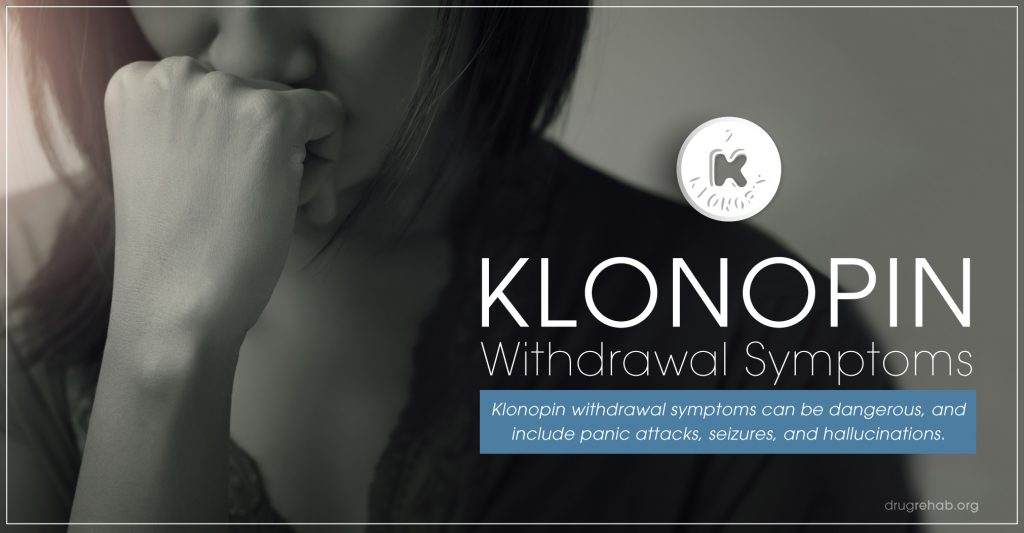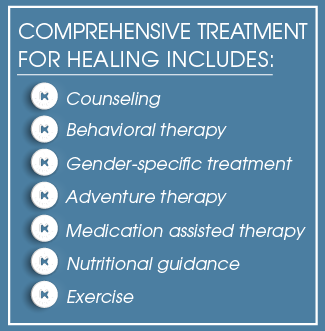
Klonopin is a long-acting benzodiazepine, or a drug that is typically used to treat anxiety and insomnia. It is a central nervous system (CNS) depressant, which means that it provides at least one of the following characteristics:
- Anticonvulsant
- Anxiety relief
- Hypnotic effect
- Memory-loss inducer
- Muscle relaxation
Benzodiazepines work by enhancing the activity of a neurotransmitter in the brain, slowing nerve reactions in the body. When people develop addiction to benzodiazepines, they may experience withdrawal symptoms when they don’t have access to or try to stop using the drugs.
Klonopin withdrawal symptoms include:
- Anxiety
- Dizziness
- Feeling of uneasiness/dissatisfaction
- Headaches
- Hallucinations
- Irritability
- Nausea
- Panic attacks
- Trouble sleeping
- Seizures
- Uncontrollable shaking
What Happens When You Take Klonopin?
While benzodiazepines treat any number of anxiety or sleep disorders, Klonopin is used most to treat panic disorder and certain seizure disorders, the National Alliance on Mental Illness (NAMI) explains. Symptoms Klonopin may help relieve include chest pain, breathing issues, heart palpitations, dizziness, nausea, and sweating.

CNS depressants like Klonopin work by inhibiting (reducing) the activity of a certain neurotransmitter (chemical messenger) in the brain. What this does is decrease brain activity, which in turn produces a calming effect, easing the symptoms mentioned above.
Because this calming effect is satisfactory, it causes your brain to begin seeking this feeling again and again. Once your brain experiences that calming feeling, it will want to experience it more—the brain adapts to this new way of activity, and expects it on a regular basis.
This is why people experience withdrawal. If you have been taking benzodiazepines like Klonopin, and abruptly stop, you experience the physical withdrawal symptoms as a result.
In fact, withdrawal and the adverse symptoms that characterize it, can keep people in the addiction cycle. If you have been abusing a drug, and start getting troublesome symptoms when you try to stop, chances are you will keep using that drug to avoid those symptoms.
How Long Does Withdrawal Last?
 The length of time withdrawal lasts depends on the person: how long abuse has been going on and the amount of abuse. Early signs of withdrawal may start as early as six to eight hours after stopping use for those who have been abusing Klonopin for a long period of time. The amount of time before withdrawal symptoms appear depends largely on how long it takes for the substance to leave your system.
The length of time withdrawal lasts depends on the person: how long abuse has been going on and the amount of abuse. Early signs of withdrawal may start as early as six to eight hours after stopping use for those who have been abusing Klonopin for a long period of time. The amount of time before withdrawal symptoms appear depends largely on how long it takes for the substance to leave your system.
Klonopin is a long-acting benzodiazepine, which means it may “accumulate in the bloodstream or take a much longer period of time to leave the body” the Center for Substance Abuse Research (CESAR) explains. For long-acting benzodiazepines, withdrawal more commonly begins within one to four days, when the substance starts to leave the body.
During this period, you may experience increased anxiety and insomnia, as well as heart and breathing rate increases, sweating, and nausea. If you don’t gain access to the drug or find a way to ease withdrawal, the symptoms usually continue for up to 10 to 14 days. However, if you’ve been exposed to long-term abuse, this period may last even longer.
What Eases Withdrawal Symptoms?
If you are undergoing withdrawal from Klonopin, the best thing you can do is taper off use of the drug. However, people who have been abusing the drug for a prolonged period of time will have to undergo detoxification from it.
Detoxification is the process that allows your body to get rid of all the toxic chemicals it gained during abuse. How is this achieved? In short, you achieve detoxification by abstaining from use of the drug. But this process can be dangerous.
Some of the side effects of withdrawal are panic attacks and seizures, and these can be intensified as you move through the detox process. For this reason, you should never attempt detox alone. Medical supervision ensures that you taper off the drugs at a safe level over a steady timeline. Should you need it, medical assistance means you will also have support in case of seizures, panic attacks, heart or breathing troubles, or any other adverse effects.
In some cases, medications can help ease withdrawal symptoms during detoxification. For example, flumazenil can stop the effects of long-acting benzodiazepines, such as Klonopin, while relieving withdrawal symptoms, according to the Drug Enforcement Administration (DEA).
What Happens In Treatment?
After detoxification, and tapering use of the drug to safe levels for abstinence, healing through treatment is the next step. We now recognize that addiction and substance abuse are conditions that affect not just the body, but also the mind. Comprehensive treatment, then, has to involve healing all aspects of the addicted individual.
That’s why our treatment centers offer an array of methods for your healing needs. We have:
 Counseling: to help you work through the thoughts and emotions that arise in treatment
Counseling: to help you work through the thoughts and emotions that arise in treatment- Behavioral therapy: such as Dialectical Behavioral Therapy to help you regain motivation and recognize your capabilities to stay free of substance abuse
- Gender-specific treatment: to treat the differing needs of men and women
- Adventure therapy: pairing skillbuilding with nature to build self-confidence and enhance motivation
- Nutritional guidance and exercise: to address the physical needs in treatment
- Medication assisted therapy: to help you manage withdrawal according to your individual timeline
Who Is Affected By Prescription Drug Abuse?
In the United States, it’s estimated that 54 million people have used prescription drugs (which include prescription opioids, CNS depressants, and CNS stimulants) at least once, according to the National Institute on Drug Abuse (NIDA). Why is this such a vast issue?
The NIDA reports this number is partly due to how easy it is to get these medications. Prescription drugs are easily obtained through a physician. For those who don’t have a prescription, they can get the medications through family or friends.
Younger people are especially affected. The highest misuse of prescription drugs is found in the 18-25 age group. Men tend to abuse prescription drugs more than women, except in youth. Yet the overdose rate, and death from overdose, continues to increase among women.
Get Help For Klonopin Addiction Today
It isn’t easy to stop Klonopin abuse. Maybe you’ve tried before, but withdrawal was too daunting. We’d like to help make it easier for you. Let us aid you in finding a treatment center that works for you, and you can get to focusing on healing. Contact us today at DrugRehab.org to learn more about Klonopin abuse and addiction and where to find treatment that meets your individual needs.
For More Information Related to “Klonopin Withdrawal Symptoms” Be Sure To Check Out These Additional Resources From DrugRehab.org:
- What Helps With Benzodiazepine Withdrawal?
- How Much Does a Drug and/or Alcohol Intervention Cost?
- The Importance of Aftercare When Leaving A Drug And/Or Alcohol Rehab Program
- The Dangers Of Snorting Vicodin (Hydrocodone)
- The Most Commonly Abused Prescription Drugs In America
Sources
Mayo Clinic—Clonazepam (Oral Route)
National Alliance On Mental Illness—Clonazepam (Klonopin)
National Institute On Drug Abuse—What Is The Scope Of Prescription Drug Misuse?
U.S. National Library Of Medicine—Clonazepam (By Mouth)


